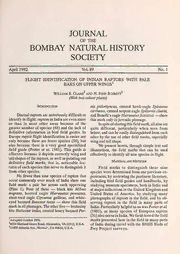
Flight identification of Indian raptors with pale bars on upper wings PDF
Preview Flight identification of Indian raptors with pale bars on upper wings
JOURNAL OF THE BOMBAY NATURAL HISTORY SOCIETY April 1992 Vol. 89 No. 1 FLIGHT IDENTIFICATION OF INDIAN RAPTORS WITH PALE BARS ON UPPER WINGS1 William S. Clark2 and N. John Schmitt3 (With two colourplates) INTRODUCTION nis ptilorhyncus, crested hawk-eagle Spizaetus cirrhatus crested serpent eagleSpilornis cheela , — , Diurnal raptors are notoriously difficult to and Bonelli’seagleHieraaetusfasciatus show identify in flight; raptors inIndiaareevenmore this markonly injuvenileplumage. so than in most other areas because of the Inspiteofsharingthisfieldmark,allnineare greater number of species (68) and the lack of quite different, particularly when seen from definitive information in bird field guides. In below, and canbe easily distinguished fromeach Europe raptor flight identification is easier not other by the use of other field marks, especially only because there are fewer species (38), but wing andtailshape. also because there is a very good specialized We present herein, through simple text and field guide (Porter et at. 1981). This guide is illustrations, the field marks that can be used effective because it depicts correctly wing and effectively to identify all nine species in flight. tailshapesoftheraptors, aswellaspointingout MaterialandMethods definitive field marks that is, noticeable fea- , tures ofeachspecies that serve to distinguish it Field marks to distinguish these nine fromotherspecies. species were determined from ourprevious ex- No fewer than nine species of raptors that periences, by reviewing thepertinentliterature, occur commonly over much of India share one including bird field guides and handbooks, by field mark: a pale bar across each upperwing studying museum specimens, bothin India and — (Plate 1). Four of these - black kite Milvus at majorcollections intheUnitedKingdomand migrans booted eagle Hieraaetus pennatus United States of America, by studying many , , short-toed eagle Circaetus ga—llicus, and white- photographs of raptors in the field, and by ob- eyed buzzard Butastur teesa sho—w this field serving raptors in the field in many parts of markinallplumages.Theotherfive brahminy India. Particularly helpfultouswas Porteretal. kiteHaliastur Indus crested honey buzzardPer- (1981), as many species of European raptors , (31)alsooccurinIndia.Wefield-testedthefield AcceptedOctober 1991. marks presented here inthe field in many parts 24554ShetlandGreenRoad,Alexandria,VA22312,U.S.A. of India during travel with the BNHS Birds of 311609AlburtisAve.,Norwal\CA90650,U.S.A. Prey Project surveys. 2 JOURNAL,BOMBAY NATURAL HIST SOCIETY, Vol.89 Results Crested honeybuzzard: Thisspecies has a distinctively long, slender neck and head that it Thefieldmarks,includingwingandtailshapes movesconstantlyfromsidetosidewhileinflight. andoverallproportions,thatwillpositivelyidentify Its comparatively narrow wings with darker eachofthe ninespecies withpalebars onupperw- secondaries on the underwing and its distinctive ingsareillustratedinPlate 1 (fromabove)andPlate tail patternaresufficient foridentification. 2(frombelow)andaresummarisedunderthehead- Crestedhawk-eagle:Comparedtotheother ing ‘Captions FOR plates/ These are discussed species considered here, it has a longer, distinc- belowinmoredetailbyspecies. tivelybandedtailandmorestronglybarredunder- Blackkite: (This nameforMilvusmigrans sides ofprimaries. The crest, ifpresent, isvisible applies to all races; pariah kite is unknown only on birds seen flying near (Plate 1). The outside ofIndia). This distinctiveraptoriscom- juvenile of the crestless changeable hawk-eagle mon, widespread, and easily identified. The Spizaetus c. limnaeetus is otherwise identical to next two species are similar and could be con- thejuvenile ofthe crested hawk-eagle. fused with it, but its long forked tail is always Crestedserpenteagle:Thisisthemosteasi- definitive. However, caution is called for be- ly identifiedofthese fourjuveniles,becauseofits cause the tail appears somewhat more square black face patches, rufous underwing markings, when fanned and a few individuals will show a strongtail pattern, and heavily streakedbreast. somewhat rounded tail. Also definitive is the Bonelli’s eagle: Juveniles of this species barring onthepale primary panels. Subspecific haverufousunderpartswhenthey fledge.Butthis differences between M. m. govinda and M. m. colourfadesratherquickly, sothatbywinterthey lineatus are not always seen in the field. appearquitecreamyontheunderparts.Theblack Booted eagle: This winter visitor is fairly lineontheunderwingmaybeprominentorindis- common overmost ofIndia and canbe confused tinct or, in some cases, even absent. One field with the black kite. Like that species it is aerial, mark,darkersecondariesonunderwing,isshared hunting on the wing from morning to afternoon. with crested honey buzzard, but the indistinct It occurs in three colour morphs: pale, dark, and banding on secondaries and tail and thickerhead newly described rufous (see Clark 1989). Dark- and shorter neck ofthis species separate it from andrufous-morphbirds aresimilartoblackkites, the other. butthewhiteuppertailcoverts,moreroundedtail, Short-toedeagle: Thisspeciesisthelargest pale ‘head lights/ and dark line through the un- ofthenine.Itspaleupperwingbarsaresomewhat derwings ofthe rufous morphare diagnostic. All wider than all the others, except those of the colourmorphs appearalike fromabove. white-eyed buzzard. The dark hood, lack of Brahminykite: Juvenilebrahminykitesare creamy tones onundersides, and strong banding similar in silhouette to black kites and booted onundeiwings are distinctive. eagles,butnotethepaleheadandbreast,rounded, White-eyedbuzzard: Thisisthesmallestof unbanded tail, and larger, creamy primarypanels the nine and is quite different fromtherest. Note ontheunderwings. particularly the narrow black tips of the outer The next four species show pale wing bars primaries, rufous tail, anduniquewing shape. only during their first year while in juvenile Acknowledgements plumage. This plumage is quite different in all fourfromtherespectiveadultplumages.All four The illustrations herein were prepared by juveniles are similarto eachotherinbeingrather Schmittto helpteachraptoridentificationtoper- palebuffytocreamyontheunderpartsandunder- sonnel of the BNHS raptor ecology project, a & wing coverts, and have less distinct pale bars on collaborative project funded by the U.S. Fish theupperwingsthandothepreviousthreespecies. Wildlife Service. We thank D. Ferguson of the J. Bombaynat.Hist.Soc. 89 Plate 1 Clark and Schmitt: Identification ofraptors — Raptorswithpalebarson upperwings Identificationfromabove. Forexplanationseecaptions(page3).
